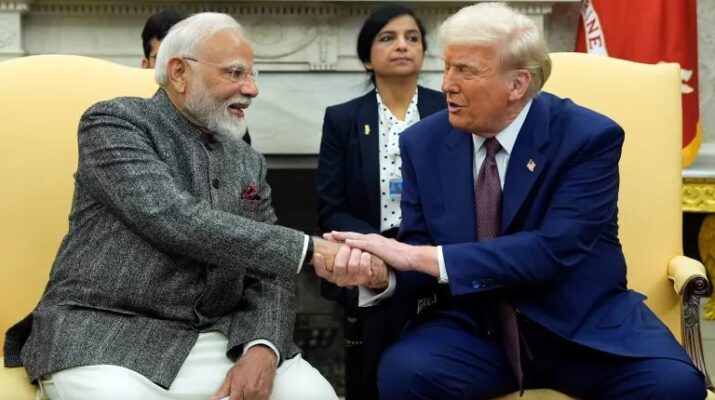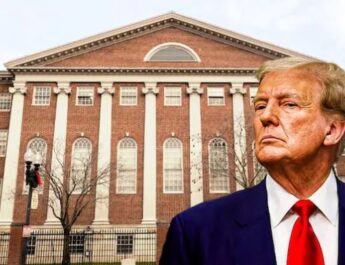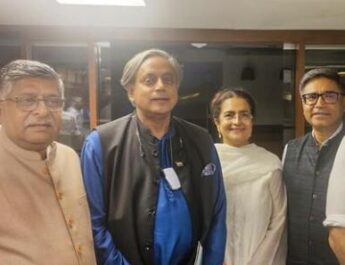New Delhi: Indian Prime Minister Narendra Modi has made his inaugural visit to the White House during Donald Trump’s second term as President of the United States. The rapport between Trump and Modi has been characterized by some media as a “bromance,” a sentiment that was evident during their meeting on Thursday. During this encounter, both leaders exchanged compliments while tactfully avoiding more contentious issues.
A primary concern was Trump’s recently introduced “reciprocal tariffs,” which suggest that he would respond to foreign import duties on American products with equivalent rates imposed by each nation.
Trump has consistently criticized India for its elevated tariff rates on imports, even reportedly referring to Modi as the “king of tariffs.” However, at the meeting, both leaders expressed their intention to develop a “framework” for enhanced collaboration.
“Prime Minister Modi and I have agreed to enter negotiations to tackle the longstanding disparities,” Trump stated, alluding to the trade dynamics between the US and India.
“Ultimately, we seek a level playing field, which we believe we are entitled to.” Moreover, their newly established framework extends beyond import tariffs to encompass partnerships in space exploration, international security, and energy trade.
Here are four takeaways from their meeting.
Modi embraces Trump’s MAGA movement
Both leaders on the right, Modi and Trump, have encountered allegations of democratic erosion within their nations. Recently, both leaders secured re-election in their respective countries: Modi in June and Trump in the previous November.
During their public engagements on Thursday, a significant portion was devoted to expressing their mutual support, with Trump praising Modi as a “great leader” and Modi referring to Trump as a “friend.”
In the midst of their camaraderie, Modi appealed to Trump’s sense of pride associated with his slogan, “Make America Great Again,” by presenting an Indian variation of the phrase.
“The citizens of America recognize President Trump’s motto, ‘Make America Great Again’ or MAGA,” Modi stated through a translator. “Adopting a phrase from the United States, our aspiration for a developed India is to ‘Make India Great Again’, or MIGA. When America and India collaborate, combining MAGA with MIGA, it results in a mega partnership for prosperity.”
As a member of the Bharatiya Janata Party (BJP), Modi also drew parallels between his Hindu nationalist agenda and Trump’s “America First” policy, asserting that he prioritizes his nation’s interests as well.
“One aspect that I greatly admire and have learned from President Trump is his unwavering commitment to national interest,” Modi remarked through a translator. “Like him, I too place the national interest of India above all else.”
India’s concessions on trade
World leaders have sought various concessions from Trump in light of the potential economic impact of significant tariffs.
For example, Mexico has deployed national guard troops to its southern border with the United States, while Canada has established a joint task force aimed at addressing fentanyl trafficking and organized crime.
On Thursday, Modi presented his own proposals intended to mitigate any economic actions Trump might consider against India. Following their private discussions, the two leaders announced a commitment to enhance trade relations, which will include collaborations in space exploration, artificial intelligence, and energy production. Modi emphasized a “new scale and scope” for their mutual goals.
“We have also set ourselves the target of more than doubling our bilateral trade to reach $500 billion by 2030,” Modi stated. As of 2024, the total trade volume between the two nations was approximately $129.2 billion, according to US government data.
Currently, the United States faces a trade deficit of $45.7 billion with India, with Indian exports to the US totaling $87.4 billion. Trump has publicly criticized such deficits, vowing to reduce them and boost US exports.
He has attributed part of the imbalance to foreign tariffs imposed on American goods. “Prime Minister Modi recently announced reductions to India’s unfair and substantial tariffs that severely restrict US access to the Indian market. This is indeed a significant issue,” Trump reiterated on Thursday.
Nevertheless, he expressed optimism, asserting that the US-India relationship is “the strongest, I believe, it’s ever been.” He also suggested that India would increase its imports of US energy products, which would help alleviate the trade deficit.
“The prime minister and I also reached a significant agreement on energy that will re-establish the United States as a leading supplier of oil and gas to India. It is hoped that we will become their primary supplier,” Trump remarked.
The President of the United States also hinted at the establishment of an international infrastructure initiative akin to China’s Belt and Road Initiative, aimed at connecting allies globally.
“We have reached an agreement to collaborate on creating one of the most significant trade routes in history. This route will extend from India to Israel, then to Italy, and ultimately to the United States, linking our partners through ports, railways, and numerous undersea cables,” Trump elaborated.
He further stated that this initiative would enable the United States to “maintain its leadership,” likely alluding to the ongoing economic rivalry with China.
A focus on combating ‘terrorism’
While the discussions were anticipated to concentrate on countering China’s global influence, another pressing security issue arose between the two nations: the threat of “terrorism.”
Significant attention was directed towards Trump’s commitment to extradite Chicago businessman Tahawwur Rana. In 2013, a federal court in the United States sentenced Rana, a Pakistani Canadian national, to 14 years in prison for “conspiracy to provide material support to a terrorist plot” targeting a news organization in Denmark.
He was also found guilty of providing material support for the 2008 Mumbai attacks, which resulted in 175 fatalities. Rana has contested his forthcoming extradition to India, where he may face the death penalty. Last month, the US Supreme Court declined to intervene in the extradition process, and with Trump’s endorsement on Thursday, it appears highly likely to proceed.
Modi commended Trump for his decision during the news conference on Thursday, likening the Mumbai attacks to a “genocide.” He assured that “appropriate action” would be taken against Rana in the Indian judicial system.
“India and the United States will stand united in the battle against terrorism,” Modi asserted. “We concur that to eradicate cross-border terrorism, we require tangible actions. I am immensely grateful to President Trump that, in 2008, a perpetrator of genocide in India – that criminal is now set to be extradited to India.”
Trump, in response, indicated that the United States would enhance military sales to India. The United States and India are set to collaborate more closely than ever before in addressing the global challenge posed by radical Islamic terrorism.
However, Prime Minister Modi has faced criticism for allegedly ignoring incidents of anti-Muslim violence and for promoting anti-Muslim rhetoric. Trump is under scrutiny regarding a potential peace agreement for Ukraine.
One recurring theme during the discussions was not directly related to US-India relations. Instead, Trump was frequently questioned by journalists about his conversations with Russian President Vladimir Putin concerning the ongoing war in Ukraine.
This conflict began in February 2022 when Russia initiated a full-scale invasion. Recently, a series of significant phone calls have sparked optimism regarding a potential peace settlement.
On that morning, Trump revealed that he had engaged in a “lengthy and highly productive phone call” with Putin, followed by a second conversation with Ukrainian President Volodymyr Zelenskyy.
While Trump and Putin discussed plans to visit each other’s nations, Ukraine and its European partners expressed growing skepticism about the negotiations.
Zelenskyy urged global leaders to be cautious and not to accept Putin’s promises without scrutiny, asserting that any peace agreement made without Ukraine’s involvement would be meaningless.
During his press conference with Modi, Trump seemed to align with Russian narratives, as Russia has long claimed that Ukraine’s aspirations to join NATO were a key factor in the conflict.
“Russia has found itself in a situation that I believe they regret. If I were president, this would not have occurred,” Trump stated.
“Currently, Russia has seized a significant amount of territory. They have consistently asserted, even before President Putin’s time, that they cannot allow Ukraine to join NATO. They have made this position very clear. I believe this was a primary catalyst for the onset of the war.”
Russia has contended that the United States provided assurances to the former Soviet Union in 1990 that NATO would not expand “one inch eastward,” although no formal agreement was established regarding this issue.
Previously, Trump expressed skepticism about the likelihood of Ukraine reclaiming the territory that Russia began to annex in Crimea in 2014. However, when questioned on Thursday about whether Russia would concede any territory in peace negotiations, Trump evaded the inquiry.




